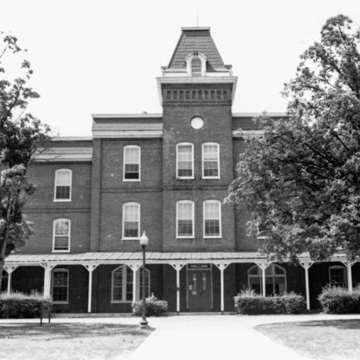The central building, Lane Hall (Barracks No. 1, 1888), is an extremely long shed-roofed three-story brick block with a mansard roof, a one-story porch across the front, and a three-part central pavilion with a mansard-roofed tower. It is surrounded by a quadrangle of much-altered brick buildings that were built with shallow hipped roofs and pilasters separating the window bays. The Performing Arts Building (1900), formerly a YMCA, was the first building to use the rough-faced limestone that became Tech's signature construction material and predates Cram's plan. The Center for the Arts (2010–2013), designed by Snohetta of Oslo, Norway, and STV Architects of Fairfax, was built by Holder Construction. Built on a site linking the town and Virginia Tech, the 150,000-square-foot complex is a regional and a university center for the arts. The concrete- and steel-framed center includes a 1,260-seat performance hall, visual arts galleries, and the Institute for Creativity, Arts and Technology. The performance hall is accessed through a five-story glass atrium. One-story art galleries link the performance hall to the cubic-shaped institute, whose exterior west wall, which has a large screen for projecting images, faces an outdoor amphitheater. The exterior of the complex is faced with the university's characteristic stone, thus relating this modern building to the campus's historic architecture.
You are here
Upper Quadrangle
If SAH Archipedia has been useful to you, please consider supporting it.
SAH Archipedia tells the story of the United States through its buildings, landscapes, and cities. This freely available resource empowers the public with authoritative knowledge that deepens their understanding and appreciation of the built environment. But the Society of Architectural Historians, which created SAH Archipedia with University of Virginia Press, needs your support to maintain the high-caliber research, writing, photography, cartography, editing, design, and programming that make SAH Archipedia a trusted online resource available to all who value the history of place, heritage tourism, and learning.


